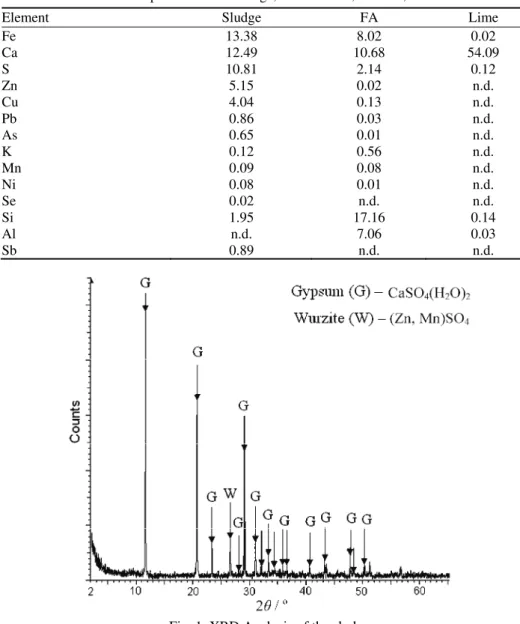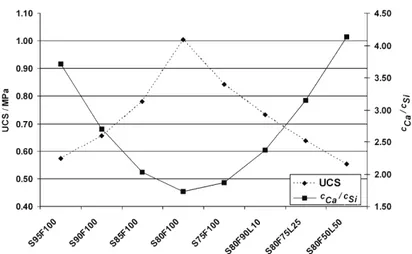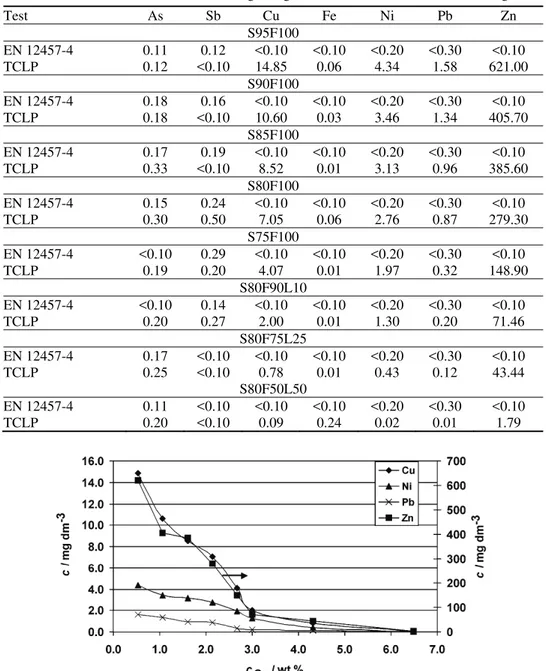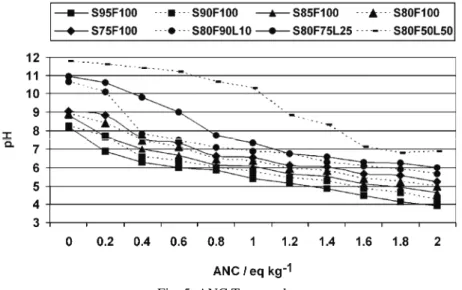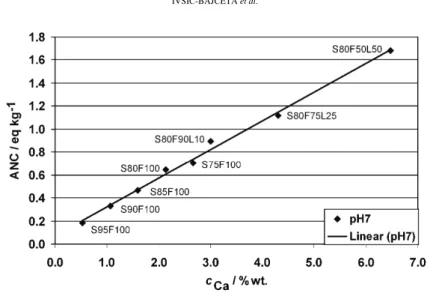JSCS–4453 Original scientific paper
A solidification/stabilization process for wastewater treatment
sludge from a primary copper smelter
DRAGANA IVŠIĆ-BAJČETA1*, ŽELJKO KAMBEROVIĆ2, MARIJA KORAĆ1 and MILORAD GAVRILOVSKI1
1Innovation Center of the Faculty of Technology and Metallurgy in Belgrade, University of
Belgrade, Karnegijeva 4, 11000 Belgrade, Serbia and 2Faculty of Technology and
Metallurgy, University of Belgrade, Karnegijeva 4, 11000 Belgrade, Serbia (Received 16 July, revised 19 November 2012)
Abstract: Wastewater treatment sludge from a primary copper smelter is characterized as hazardous waste that requires treatment prior to disposal due to its significant contents of heavy metals and arsenic. The aim of the presented study was to investigate the feasibility and the effectiveness of a solidifica-tion/stabilization process of the sludge using fly ash and lime as binders. The effectiveness of the process was evaluated by Unconfined Compressive Strength (UCS) testing, leaching tests (EN 12457-4 and Toxicity Characteristic Leaching Procedure (TCLP)) and Acid Neutralization Capacity (ANC) tests. All the samples reached the target UCS value of 0.35 MPa. The calcium to silicon concentration ratio (cCa/cSi), determined by X-ray fluorescence analysis, was identified as main factor governing strength development. Inductively coupled plasma-optical emission spectrometry analyses of solutions after leaching tests showed excellent stabilization of Cu, Ni, Pb and Zn (above 99 %) and arsenic (above 90 %) in samples with high Ca(OH)2 content. Results of the ANC test indicated that the buffering capacity of solidified material linearly depended on Ca concentration in FA and lime. Samples with 20 % of binder having 50 % of FA and 50 % of lime met all the requirements for safe disposal.
Keywords: fly ash; lime; heavy metals; unconfined compressive strength; leaching tests.
INTRODUCTION
Wastewaters produced during gas cleaning and cooling processes and elec-trolytic refining in the Copper Smelter RTB Bor in Serbia are currently dis-charged without previous treatment. These wastewaters, the amount of which occasionally have reached several hundred cubic meters per hour, represent a major environmental problem for the western Balkans and the Danube Basin.1
The construction of a wastewater treatment (WWT) plant is planned during Bor Copper Smelter – Acid Plant Modernization Project in next few years. Genera-tion of WWT sludge, bearing significant amount of heavy metals and arsenic, is estimated at 11.2 t h–1.2 This copper WWT sludge is characterized as hazardous waste in the Waste Catalogue (also adopted in Serbian law3) by the code 19 02 05*, and must be chemically and physically treated prior to disposal in order to prevent secondary pollution. The aim of presented study was to investigate the feasibility and the effectiveness of a solidification/stabilization (S/S) process of future copper WWT sludge as an addendum to the ongoing project.
An S/S process is recognized as “the best demonstrated available techno-logy” for treatment of industrial waste containing heavy metals.4,5 It involves mixing a binding reagent with contaminated media or waste, changing the chemi-cal and physichemi-cal properties of hazardous materials to make it suitable for land disposal. Cement is the most frequently used binder for S/S treatment of hazard-ous waste.5 In order to improve economic and environmental effects of the pro-cess, nowadays, cement is increasingly replaced by fly ash (FA), which is an excellent example of a cost effective utilization of a waste product.6 In Serbia alone, about 5 million tons of ash is generated annually during coal combustion in thermal power plants.7 Besides benefits in the use of waste materials such as FA, compared to other more expensive binders in S/S processes, FA increases the pH region for heavy metals immobilization and improves the mechanical pro-perties of the treated waste.6 In the S/S treatment of heavy metals- and arsenic-bearing waste, FA as a binder is usually used individually8,9 or in mixtures with Portland cement and lime.4,10
The quality of an S/S process is determined by the compressive strength and leaching resistance of the treated material. Development of strength and immo-bilization of metal ions in waste primarily depend on the products of hydration reaction of pozzolanic components in FA (SiO2, Al2O3, CaO and Fe2O3).11 The optimum amounts of pozzolans present in waste, or their addition, can lead to better mechanical properties of a material.12,13 The hydration reaction is influ-enced by the nature and relative quantity of the waste.14 It is generally believed that heavy metals ions present in the waste can affect the pozzolanic reaction by precipitation of insoluble Ca–heavy metals15 and Ca–As16,17 salts on the new formed hydrates. Precipitated salts can prevent further hydration and inhibit the development of the hydrated structure.18,19
of binder that would ensure stabilization of the pollutants and prevent their mig-ration into the environment.
The presented study investigates the possibility of employment of an S/S process on the sludge from the WWT plant in the future modernized RTB Bor Copper Smelter – Acid Plant using FA and mixture of FA and lime as binders. Process optimization was achieved by varying content and composition of the binder. UCS Testing and the standardized leaching tests: EN 12457-4, TCLP and ANC tests were used to determine the effect of the binder on strength develop-ment and heavy metals/arsenic ion immobilization. The results provide a novel clarification of the effect of pozzolans on the quality of the S/S process.
EXPERIMENTAL
The experiments were conducted on synthesized sludge that chemically and physically corresponded to the future WWT sludge defined by the Modernization Project with 50.67 mass % water content and a density of 1.55 kg dm-3. Basic materials for the synthesis of WWT sludge were systematically collected dusts from the electro-filters of the reactor and converter in the Bor Copper Smelter. The synthesis of the sludge under laboratory conditions was described in detail previously.24
FA from the Bor heating plant, Serbia was used as the sole binder and in mixtures with commercial grade hydrated lime (“Nexe”, Jelen Do). The FA originated from the combustion of lignite coal from the Kolubara mines in Serbia. Due to conditions of storage and transport, the FA had to be dried at 105 °C for 24 h and sieved in order to obtain <100 µm fraction for the further experiments.
The chemical composition of the sludge, FA and lime, and the mineralogical compo-sition of the sludge were determined by X-Ray fluorescence (XRF) and X-Ray diffraction (XRD) analyses, respectively. The pollution potentials of the sludge and FA were evaluated by EN 12457-4 and TCLP tests. These two leaching tests have both been adopted into Serbian Law3 for the testing of the hazardous characteristics of waste and are described below.
In order to optimize the composition of the S/S mixture, eight series of experiments with different additions and compositions of binder were prepared. The compositions of the S/S mixtures are presented in Table I.
TABLE I. Compositions of the S/S mixtures, mass %
Sample Binder composition Sludge:binder
FA Lime
S95F100 100 – 95:5
S90F100 100 – 90:10
S85F100 100 – 85:15
S80F100 100 – 80:20
S75F100 100 – 75:25
S80F90L10 90 10 80:20
S80F75L25 75 25 80:20
S80F50L50 50 50 80:20
plastic molds dimensions 5×5×5 cm3 and vibrated in order to remove entrapped air and excess water. The specimens were cured according to the ASTM C109 Standard:25 24 h under wet towels to meet the requirement of 99 % moisture; after 3 days, the samples were removed from the mold and left to cure in air.
The UCS test provides basic information on material stabilization. According to the U.S. Environmental Protection Agency (USEPA), 0.35 MPa is the minimum compressive strength required for the safe disposal of stabilized waste.5 The UCS values of the samples were deter-mined after 7, 14 and 28 days of curing using a servo hydraulic testing machine type Instron 1332-retrofitted Fast track 8800 with a maximum load of 100 kN. The presented results are the mean measurements of three samples.
Leaching procedures allow the characterization of the environmental behavior of wastes and S/S products using the solubility and/or availability of pollutants as limits. TCLP26 and EN 12457-427 are very common tests, standardized and accepted in the USA and the EU for evaluating the pollution potential of materials. The EN 12457-4 test was conducted after 28 days of curing to simulate long-term leaching processes at disposal sites. Distilled water was used as the extraction fluid at a liquid to solid (L/S) ratio of 10. Crushed samples (<10 mm, 100 g) were leached by rotating for 24 h in polyethylene bottles. TCLP tests, simulating the worst-case scenario, were conducted after curing the samples for 180 days. For this purpose, 50 g of ground samples (<10 mm) were placed in polyethylene bottle together with 1.0 dm3 of extraction fluid (L/S 20). A solution of glacial acetic acid having a pH value of 2.88±0.05 was used as the extraction fluid. The mixture was agitated for 18±2 h. After the leaching tests, the solutions were filtered through a blue ribbon filter paper. The metal concentrations in the solu-tions were determined by atomic absorption spectroscopy (AAS) (after the EN 12457-4 test) and by inductively coupled plasma-optical emission spectrometry(ICP-OES) (after the TCLP test).
The ANCtest provides information on the buffering (acid neutralization) capacity of S/S materials and thus their resistance to various environmental conditions at landfills. The ANC test was adapted from the Environment Canada procedure described by Stegemann and Cote.28 The test consists of a series of batch extractions with increasing additions of nitric acid, ranging from distilled water to 2.0 M HNO3 over 11 equal increments. The samples cured for 180 days were crushed, sieved to <125 µm and dried at 60 °C to constant weight. Samples of 3 g were placed in 50 cm3 polyethylene bottles together with distilled water and 1 M HNO3 to give an L/S ratio of 10 and the desired acid addition. The bottles were sealed and rotated for 48 h prior to centrifugation and measurement of the pH. Measured pH values were plotted against the equivalent mass of acid added per kg of dried material, eq. kg-1, for each individual mixture.
In order to determine the chemical composition of the S/S samples and its influence on the compressive strength and leaching resistance of the waste, XRFanalysiswas performed using a Niton XRF instrument.
RESULTS AND DISCUSSION
Chemical composition of the sludge, FA and lime, determined by XRF anal-ysis, are presented in Table II. The metals in the sludge were in the form of sul-fates and hydroxides and in FA in the form of oxides. By its chemical composi-tion, the employed FA belonged to class F according to the ASTM C618 stan-dard.29 XRD Analysis of the sludge, Fig. 1, revealed that the main mineral phase was gypsum (CaSO4·2H2O).
TABLE II. Chemical composition of the sludge, FA and lime, mass %; n.d. – not detected
Element Sludge FA Lime
Fe 13.38 8.02 0.02
Ca 12.49 10.68 54.09
S 10.81 2.14 0.12
Zn 5.15 0.02 n.d.
Cu 4.04 0.13 n.d.
Pb 0.86 0.03 n.d.
As 0.65 0.01 n.d.
K 0.12 0.56 n.d.
Mn 0.09 0.08 n.d.
Ni 0.08 0.01 n.d.
Se 0.02 n.d. n.d.
Si 1.95 17.16 0.14
Al n.d. 7.06 0.03
Sb 0.89 n.d. n.d.
The pollution potentials of the sludge and FA, evaluated by the EN 12457-4 and TCLP tests, are presented in Table III. The EN 12457-4 test showed leaching of Zn and Sb and the TCLP test showed leaching of Zn and Cu above the regu-lation limits.
TABLE III. Pollution potential of the sludge and FA compared with national legislative for non-hazardous waste
Metal EN 12457-4, mg 100 g-1 dried material TCLP, mg dm-3
Sludge FA Limit Sludge FA Limit
Fe <0.1 <0.1 – 3.9 <0.1 –
Ca 604.2 638.9 – 951.4 1784.7 –
Zn 16.0 0.1 5 1232.6 0.05 250
Cu <0.1 <0.1 5 26.2 <0.1 25
Pb <0.3 <0.3 1 3.45 <0.3 5
As 0.14 <0.1 2 2.6 <0.1 5
Ni 0.42 <0.2 1 7.4 <0.2 20
Sb 0.27 <0.1 0.07 3.1 <0.1 15
The main metal constituents of the solidified material, as determined by XRF analysis and presented in Table IV, were Fe, Ca, Zn, Cu and Si, which were expected considering the nature of the sludge and FA.
TABLE IV. Concentrations of metals in the solidified samples, c / mass %
Sample Fe Ca Zn Cu Si Pb As Ni Mn
S95F100 13.06 10.06 5.61 4.60 2.71 0.90 0.69 0.08 0.08 S90F100 11.79 9.40 4.44 3.93 3.47 0.75 0.58 0.07 0.06 S85F100 12.03 8.59 4.07 3.67 4.23 0.69 0.53 0.05 0.07 S80F100 10.64 8.66 3.38 2.90 4.99 0.58 0.45 0.06 0.07 S75F100 11.53 10.74 3.23 2.80 5.75 0.57 0.44 0.05 0.07 S80F90L10 10.94 11.03 3.49 3.13 4.65 0.61 0.46 0.05 0.06 S80F75L25 10.06 13.03 3.77 3.18 4.14 0.61 0.50 0.05 0.06 S80F50L50 8.00 13.53 3.57 2.81 3.28 0.57 0.47 0.05 0.05
The results of the testing after 7, 14 and 28 days for systems of different compositions are given in Table V.
TABLE V. Results of UCS testing after 7, 14 and 28 days
Sample UCS / MPa
7th day 14th day 28th day
S95F100 0.40 0.45 0.57
S90F100 0.39 0.57 0.66
S85F100 0.40 0.66 0.78
S80F100 0.40 0.79 1.00
S75F100 0.40 0.58 0.84
S80F90L10 0.51 0.67 0.73
S80F75L25 0.35 0.47 0.64
S80F50L50 0.32 0.73 0.55
Addition of lime resulted in a decrease in the UCS after 28 days of curing. In the work performed by Antiohos and Tsimas, this was explained by insufficient silica present in the samples to react completely with the excess of hydrated lime.12 The remaining unreacted Ca(OH)2 exerted a negative affect on the strength development and possibly some durability properties.30 The assumption about more than the optimum amount of Ca(OH)2 for the pozzolanic reaction was con-firmed by calculating the Ca to Si concentration ratio (cCa/cSi) in the samples determined by XRF analysis. This ratio provides information of the available pozzolans for the formation of cementious phases in the waste. The correlation between the UCS, developed after 28 days of curing, and the corresponding cCa/cSi
ratio is presented in Fig. 2. An increase in the cCa/cSi ratio in the system resulted in a reduction of the UCS due to higher amount of unreacted Ca(OH)2. The highest compressive strength was achieved for a cCa/cSi ratio of 1.73 (sample S80F100), which was the lowest one. The ratios of the Ca concentration with the concentration of others elements were also analyzed but there was no agreement with the results of the UCS. This confirmed the major role of the silica concen-tration in governing the development of the UCS in waste samples.31
of As in the treated samples were very similar and the results evidenced no corre-lation between As leaching and FA/lime addition, although it was reduced by over 90 % compared to the leaching from the untreated sludge. The concentra-tions of Sb were below the detection limit for most samples.
Fig. 2. UCS Values after 28 days and the corresponding Ca to Si concentration ratios (cCa/cSi) in the solidified samples, determined by XRF analysis.
Although both tests are accepted in the National Law, the results of the EN 12457-4 and TCLP tests gave different toxicological characterization of the same waste. The Zn concentrations in the solutions after the EN 12457-4 tests were below 0.1 mg 100 g–1 dried material for all samples and the S/S waste could be characterized as non-hazardous. However, according to the TCLP results, samples S95F100, S90F100, S85F100 and S80F100 had Zn leached concentrations above the concentration limits defining non-hazardous waste. The pH value of the ex-traction fluid was the main parameter governing the leaching of pollutants. The aggressive extraction fluid in the TCLP test can neutralize all alkalinity in an S/S sample and lead to much higher leaching of metals. The alkalinity of S/S waste samples depends on the content of CaO and Ca(OH)2 derived from FA and lime. The Ca concentration in samples in the form of CaO and Ca(OH)2 can be cal-culated according to FA and lime additions (Ca concentration in the binder). The influence of the alkalinity (presented as the Ca concentration in the binder, cCa / / mass %) on heavy metals leaching during the TCLP tests is presented in Fig. 3. A larger amount of Ca in the form of CaO and Ca(OH)2 in the samples resulted in a reduction of heavy metals leaching.
The Eh and pH values of each filtrated solution after leaching were measured.
These data were used for metal ions speciation in Eh–pH diagrams. Diagrams
TABLE VI. Results of EN 12457-4 test, mg 100 g-1 of dried material and TCLP test, mg dm-3
Test As Sb Cu Fe Ni Pb Zn
S95F100
EN 12457-4 0.11 0.12 <0.10 <0.10 <0.20 <0.30 <0.10
TCLP 0.12 <0.10 14.85 0.06 4.34 1.58 621.00
S90F100
EN 12457-4 0.18 0.16 <0.10 <0.10 <0.20 <0.30 <0.10
TCLP 0.18 <0.10 10.60 0.03 3.46 1.34 405.70
S85F100
EN 12457-4 0.17 0.19 <0.10 <0.10 <0.20 <0.30 <0.10
TCLP 0.33 <0.10 8.52 0.01 3.13 0.96 385.60
S80F100
EN 12457-4 0.15 0.24 <0.10 <0.10 <0.20 <0.30 <0.10
TCLP 0.30 0.50 7.05 0.06 2.76 0.87 279.30
S75F100
EN 12457-4 <0.10 0.29 <0.10 <0.10 <0.20 <0.30 <0.10
TCLP 0.19 0.20 4.07 0.01 1.97 0.32 148.90
S80F90L10
EN 12457-4 <0.10 0.14 <0.10 <0.10 <0.20 <0.30 <0.10
TCLP 0.20 0.27 2.00 0.01 1.30 0.20 71.46
S80F75L25
EN 12457-4 0.17 <0.10 <0.10 <0.10 <0.20 <0.30 <0.10
TCLP 0.25 <0.10 0.78 0.01 0.43 0.12 43.44
S80F50L50
EN 12457-4 0.11 <0.10 <0.10 <0.10 <0.20 <0.30 <0.10
TCLP 0.20 <0.10 0.09 0.24 0.02 0.01 1.79
Fig. 3. Dependence of the concentrations of heavy metals, c, in solutions after leaching on the Ca concentration in the binder, cCa.
during leaching: the As concentrations remained almost constant while the Zn concentrations were reduced by 99 % with the addition of lime. The Eh–pH
diagram of As and Zn are shown in Fig. 4, combined with their concentrations in solution after leaching, c / mg dm–3. Different additions and compositions of
bin-der did not effect arsenic leaching. In all systems, As remained in the soluble form as HAsO3–. Concentrations of As were in the range from 0.1 to 0.3 mg dm–3 in solutions after the TCLP leaching test of stabilized waste. The As concentra-tion was ten times reduced compared to its concentraconcentra-tion in soluconcentra-tion of untreated sludge although in the same area of HAsO3–. This implies that, beside the for-mation of insoluble Ca–As salts, the binder effects the stabilization of As ions by increasing the pH value of the matrix and, possibly, by other physicochemical interactions. In contrast to arsenic, different amounts and composition of binder affected Zn leaching. The addition of FA caused an increase in the pH value of the material and zinc transformed from its soluble form into insoluble oxides. The Zn concentration in the S75F100 solution was reduced to below the regulation limits (200 mg dm–3). Lime addition resulted in better Zn stabilization and in sample with 50 % of Ca(OH)2 in binder (S80F50L50), zinc leaching was reduced by 99.8 %.
The ANC test was conducted for determining the buffering capacity of the S/S samples. Since the S/S process is pH-dependent, sufficient acid neutralizing capacity is necessary to stabilize the heavy metals. The ANC test results pre-sented in Fig. 5 show the pH value of leachates as a function of added equiva-lents of nitric acid per kilogram of dried sample, ANC in eq. kg–1. These figures
are known as titration curves and a plateau at a defined pH describes the waste buffer capacity. A material has a larger buffering capacity if it can neutralize more equivalents of acid.
Fig. 5. ANC Test results.
Samples with FA as binder had initial pH values between 8 and 9, and a lower decrease at around pH 6. The reason for this was, primarily, the presence of gypsum and other sulfates with a buffering capacity around pH 5–6,32 and a significant content of iron and zinc in the WWT sludge having a buffering capa-city also around pH 5–6.33 The amount of acid that a stabilized material could neutralize (at pH 7) increased with the amount of FA in the samples, from 5 to 25 %. The samples with added lime had greater buffering capacities. The acid neu-tralization capacity, ANC, depends on the amount of alkaline reagents in the S/S
waste, while pozzolanic agents have negative effects on the buffering capacity with nitric acid, due to the substitution of basic reagents by acidic oxides.34 In addition, alkalis in FA are combined in the glassy phase and the amorphous silica in FA might react with the alkalis rendering them less available.21 In the litera-ture, the ANC was found to be a function of the calcium containing compounds in
Fig. 6. ANC at pH 7 as a function of the Ca concentration in the binder, cCa.
Stegemann and Cote proposed that the S/S product should have an ANC
greater than 1 eq. kg–1 before reaching pH 9 in order to be disposed at a segre-gated landfill.37 Only sample S80F50L50 met this condition. The reasons why the other samples did not fulfill this condition were primarily the chemical com-position of the WWT sludge and the use of FA as the main binder.
CONCLUSIONS
In the presented study, it was observed that solidification and stabilization of WWT sludge from a Copper Smelter bearing high amounts of heavy metals and arsenic was possible using FA in mixtures with lime. All samples with different addition and composition of binder had UCS above the required 0.35 MPa after
28 days of curing. The cCa/cSi ratio was found to be the main factor governing strength development. With addition of lime, there was not enough silica present in waste to react with the surplus of Ca(OH)2. Unreacted Ca(OH)2 caused a decrease in the UCS values. In the leachates after the EN 12457-4 test, the
con-centration of Zn and Ni were under 0.1 and 0.2 mg 100 g–1 dried material, res-pectively. Different additions and compositions of binder had no influence on the leaching As and Sb. On the other hand, the results of the TCLP tests revealed stabilization of Cu, Ni, Pb and Zn by over 99 % and As by over 90 % with addi-tion of 50 % of lime to the FA. Heavy metals leaching was reduced with increas-ing calcium concentration in the form of CaO and Ca(OH)2 (Ca concentration in binder), probably due to the formation of insoluble Ca–heavy metals salts and by increasing the pH value of the waste. The difference in the extraction fluids em-ployed in the EN 12457-4 and TCLP leaching tests resulted in different toxicity characterization of the same waste. Acid neutralization (buffering) capacity,
The results showed a linear dependence of the buffering capacity on the Ca con-centration in the form of CaO and Ca(OH)2. However, only the sample with 50 % of lime added to the FA had an ANC value above required one. The reasons for
this were the high gypsum and heavy metals concentrations in the WWT sludge and employment of FA as the binding agent. Sample with optimal addition of 20 % of binder containing 50 % of lime mixed with FA met all the requirements for safe disposal. Although the addition of lime to FA decreased the UCS, it was
necessary for a better stabilization of the heavy metals and an increase in ANC
value. Results of conducted tests indicate that the optimum amount of pozzolans present in the material could lead to the successful solidification/stabilization of WWT sludge bearing high amounts of heavy metals and arsenic.
Acknowledgments. This work was financially supported by the Ministry of Education, Science and Technological Development of the Republic of Serbia, Project No. 34033.
И З В О Д
ПРОЦЕССОЛИДИФИКАЦИЈЕ/СТАБИЛИЗАЦИЈЕЗАТРЕТМАНОТПАДНИХВОДА
МУЉАИЗПРИМАРНЕТОПИОНИЦЕБАКРА
ДРАГАНАИВШИЋ-БАЈЧЕТА1
, ЖЕЉКОКАМБЕРОВИЋ2
, МАРИЈАКОРАЋ1
иМИЛОРАДГАВРИЛОВСКИ1
1Иновационицентар
Tехнолошко–металуршкогфакултетауБеограду, УниверзитетуБеограду, Карнегијева 4, 11000 Београди2Технолошко–металуршкиФакултет, УниверзитетуБеограду,
Карнегијева 4, 11000 Београд
Муљкојинастајетретманомотпадневодеизпримарнетопиницебакрапредставља
опасанотпадкојисеморатретиратипреодлагањауследвисокогсадржајатешкихме
-талаиарсена. Циљпрезентованоградајеиспитивањеизводљивостииефикасностипро
-цесасолидификације/стабилизацијеовогмуљакоришћењемлетећегпепелаихидрати
-саног кречакаоагенса застабилизацију. Ефикасност процесасеодређиваламерењем
притиснечврстоће (УЦС) солидификата, тестовималужења (EN 12457-4 иToxicity
Cha-racteristic Leaching Procedure (TCLP)) итестомкапацитетазанеутрализацијукиселине
(ANC test). Свииспитиваниузорцисуималипритиснучврстоћуизнадзахтеваних 0,35
MPa. Односконцентрацијакалцијумаисилицијума (cCa/cSi) уузорцима, одређенренд
-генско–флуоресцентноманализом, јеидентификованкаоглавнифакторразвојапритис
-не чврстоће. Оптичкаемисиона спектрометријска анализа са индуковано спрегнутом
плазмомрастворанаконтестовалужењајепоказалаодличнустабилизацију Cu, Ni, Pb и
Zn (изнад 99 %) иарсена (изнад 90 %) уузорцимасависоким садржајем Ca(OH)2. Ре
-зултати ANC теста указују нато да пуферски капацитет солидификованогматеријала
линеарнозависиодконцентрације Ca улетећемпепелуикречу. Узоракса 20 % везива
састава 50 % летећипепеои 50 % хидратисаникречиспуњавасвезахтеванеусловеда
будебезбедноодложен.
(Примљено 16. јула, ревидирано 19. новембра 2012)
REFERENCES
1. M. Korać, Ž. Kamberović, Metalurgija – J. Metallurgy13 (2007) 41
3. Regulation on categories, testing and classification of waste, Official Gazette of the Republic of Serbia, No. 56/10 (in Serbian)
4. T. S. Singh, K. K. Pant, J. Hazard. Mater.131 (2006) 29 5. R. Malviya, R. Chaudhary, J. Hazard. Mater.137 (2006) 267 6. D. Dermatas, X. Meng, Eng. Geol.70 (2003) 377
7. M. Komljenović, Z. Baščarević, V. Bradić, J. Hazard. Mater. 181 (2010) 35 8. L. M. Camacho, S. H. Munson-McGee, J. Hazard. Mater. 137 (2006) 144 9. D. H. Moon, D. Dermatas, J. Hazard. Mater.141 (2007) 388
10. M. Erdem, A. Özverdi, Hydrometallurgy105 (2011) 270 11. M. Ahmaruzzaman, Prog. Energ. Combust.36 (2010) 327 12. S. K. Antiohos, S. Tsimas, Cement Concrete Res. 34 (2004) 769 13. S. Lim, W. Jeon, J. Lee, K. Lee, N. Kim, Water Res. 36 (2002) 4177 14. J. N. Diet, P. Moszkowicz, D. Sorrentino, Waste Manage.18 (1998) 17 15. X. C. Qiao, C. S. Poon, C. R. Cheeseman, J. Hazard. Mater.139 (2007) 238 16. W. H. Choi, S. R. Lee, J. Y. Park, Waste Manage.29 (2009) 1766
17. C. Sullivan, M. Tyrer, C.R. Cheeseman, N. J. D. Graham, Sci. Total Environ.408 (2010) 1770
18. A. K. Minocha, N. Jain, C. L. Verma, Cement Concrete Res.33 (2003) 1695
19. M. F. M. Zain, M. N. Islam, S. S. Radin, S. G. Yap, Cement Concrete Comp.26 (2004) 845 20. C. F. Pereira, M. Rodrı́guez-Piñero, J. Vale, J. Hazard. Mater.82 (2001) 183
21. X. D. Li, C. S. Poon, H. Sun, I. M. C. Lo, D. W. Kirk, J. Hazard. Mater.82 (2001) 215 22. M. Polat, E. Guler, E. Lederman, H. Cohen, Waste Manage.27 (2007) 482
23. S. Srivastava, R. Chaudhary, D. Khale, J. Hazard. Mater.153 (2008) 1103
24. D. Ivšić-Bajčeta, Ž. Kamberović, M. Korać, B. Anđelić, V. Trujić, in Proceedings of the XIX International Scientific and Professional Meeting “Ecological Truth, EcoIst 11”, Bor, Serbia, 2011, p. 420
25. American Society for Testing and Materials, ASTM C109: Standard test method for compressive strength of hydraulic cement mortars (using 2-in. or [50-mm] cube specimens), Annual Book of ASTM Standards, 2001, p. 83
26. United States Environmental Protection Agency (USEPA), Test Methods for Evaluating Solid Waste, SW- 846, Method 1311: Toxicity Characteristic Leaching Procedure (TCLP), 1992
27. European Committee of Standardization, EN 12457-4: Characterization of waste - Leaching - Compliance test for leaching of granular waste materials and sludges - Part 4: One stage batch test at a liquid to solid ratio of 10 l/kg for materials with particle size below 10 mm (without or with size reduction), CEN/TC 292,2002, p. 28
28. J. A. Stegemann, P. L. Cote, Waste Manage.10 (1990) 41
29. American Society for Testing and Materials, ASTM C618: Standard specification for coal fly ash and raw or calcined natural pozzolan for use in concrete, Annual Book of ASTM Standards,2005
30. M. S. Konsta-Gdoutos, S. P. Shah, Cement Concrete Res.3 (2003) 1269
31. S. K. Antiohos, V. G. Papadakis, E. Chaniotakis, S. Tsimas, Cement Concrete Res.37 (2007) 877
32. Q. Y. Chen, M. Tyrer, C. D. Hills, X. M. Yang, P. Carey, Waste Manage.29 (2009) 390 33. A. Coz, A. Andrés, S. Soriano, J. R. Viguri, M. C. Ruiz, J. A. Irabien, J. Hazard. Mater.164
34. A. Coz, A. Andrés, S. Soriano, Á. Irabien, J. Hazard. Mater.109 (2004) 95 35. A. G. Kim, Fuel85 (2006) 1403
36. C. S. Poon, K. W. Lio, Waste Manage.17 (1997) 15

